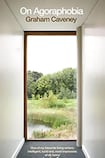
“Agoraphobia. I want to write the word in the middle of the page, leave it stranded, surrounded with nothing but icy white space…An insufficient word for a condition of insufficiency.” From about the age of 20, Graham Caveney began to suffer from what was eventually diagnosed as agoraphobia and for 30-plus years he’s been managing it and learning to live within the narrow limits it’s imposed on his life.
He quotes Lori Moore: “Literature is the correspondence of two agoraphobics. It is lonely and waited for, brilliant and pure and frightened, a marriage of birds, a conversation of the blind.” Thus, his quest to understand his condition brought him back to his primary love, books, where so many authors and fictional characters have agoraphobia, such as Ford Madox Ford, Emily Dickinson, Shirley Jackson, Harper Lee’s Boo Radley, Wilkie Collins’s Mr Fairlie, Angela Carter’s Fevvers. His exploration of these and many others yields fascinating insights into the illness.
There’s much autobiography: schoolyard bullying that he endured; sexual abuse by a Catholic priest; having to move back in with his parents in adulthood; alcohol and medical drug dependency; detox and the slow rehab process. He describes, fluently and graphically, his first attack, at 19, on a bus on his way back to university after Christmas holidays.
“I was suddenly at a funfair, an internal carnival whose control settings were not my own. A rollercoaster lurch in the stomach, the tightening twirl of the solar plexus, an offbeat disco of the heart. A funless, unfunny, no fun funfair.” He compares the panic to a pitbull shaking a ragdoll: “It churns up the intestines, gnaws and chews at the lungs and throat.”
Graham Caveney has the book because he believes the links between writing and agoraphobia are manifold
Motorways, dual carriageways and unknown open roads are “non-negotiable” for him; airports, shopping centres and busy main roads are “difficult”, and canals, parks and supermarkets are “variable”.
He’s written the book because he believes the links between writing and agoraphobia are manifold: “Blank spaces, infinite possibilities, paralysing freedom. Writing discovers where it wants to go by getting there. It demands you become your own cartographer.”
He closes by quoting Alice to the Caterpillar: “I’m afraid I can’t explain myself, sir, because I’m not myself, you see?” Beautifully written, this is an honest, painful but ultimately hopeful book.










